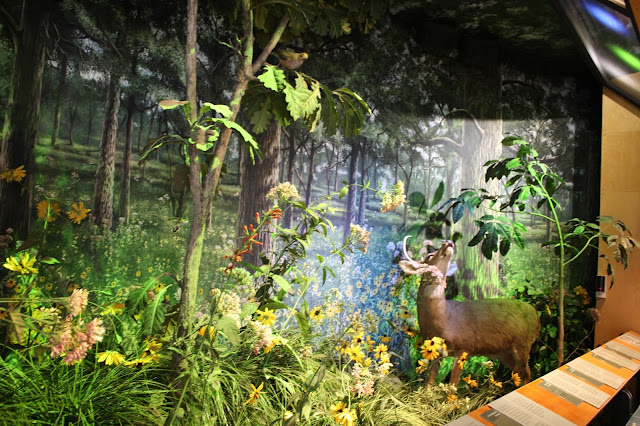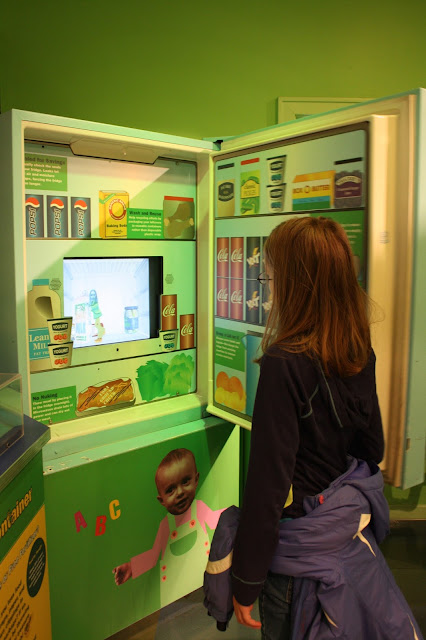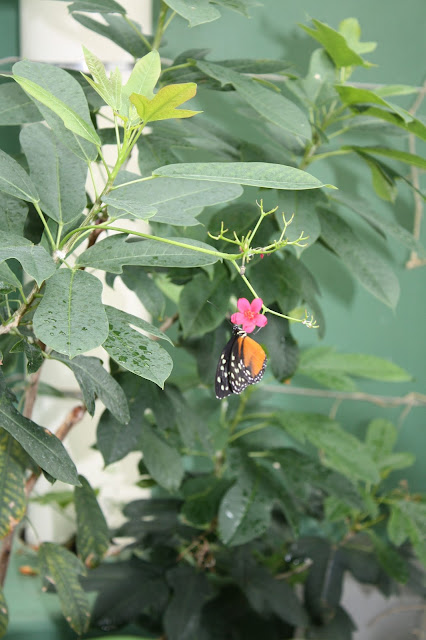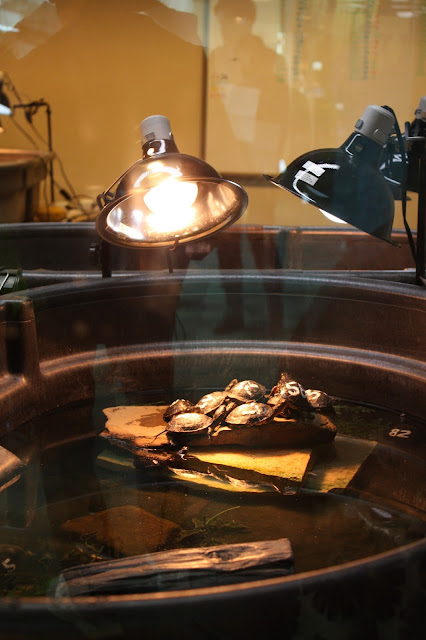With the renewal of spring unfolding right before our eyes and Earth Day later this month, now is the perfect time to think about conservation. We recently explored the Peggy Notebaert Nature Museum in Chicago and uncovered the perfect place for children to examine the natural world and learn the importance of conservation while taking home ways that they themselves can make a difference.
 |
| A chickadee visits the bird walk. |
The
Peggy Notebaert Nature Museum provides Chicago with a nature haven throughout the entire year. Even before entering the structure, families can witness a prairie that no doubt teems with a cornucopia of native plants throughout warmer months. Also outside, the bird walk invites an amazing array of birds even though city skyscrapers are not far away. We saw quite a collection of birds along the walk despite the chilly weather during our visit. A joy!
Inspiring Conservation
From the minute you step in, the Peggy Notebaert Nature Museum inspires conservation. With its impressive collection of taxidermy specimens, the museum recreates scenes illustrating how ecosystems in Illinois appeared before development altered the landscape. Through the scenes, children witness changes we have made to the environment. This experience gives them the tools to think more critically about their role in affecting ecosystems.
 |
| Deer nibbling in the savanna. |
Empowering Children in Conservation
The museum does a fabulous job of empowering children to make changes in their own homes that have an impact. The Extreme Green House shows families the ecology living in our houses and presents practical solutions to making our homes & lifestyles more eco-conscious. The home exposes several rooms of a typical home and provides families with manageable eco-friendly changes they can make. Hands-on and digital portions of the exhibit reach out to children.
 |
| How do we reduce waste and energy usage in the home? |
Not to be missed is the basement portion of the Green House. Certainly one of my favorite exhibits! A cutaway house hows how various systems with in the house work including heating and water. Typical items found in a basement are broken down and visitors are taught tips to be more eco-conscious and energy efficient.
 |
| Take a peek inside and see how the systems in the house flow! |
Judy Istock Butterfly Haven
One of the most celebrated portions of the Peggy Notebaert Nature Museum is the Judy Istock Butterfly Haven. With butterflies of all shapes and sizes born throughout the whole year and then sent to populate a tranquil conservatory, the haven affords visitors a year-round oasis even during Chicago's harsh winters! The haven also serves a larger purpose through bolstering endangered populations of native butterflies.
 |
| An up close view of a butterfly in the haven. |
We certainly were caught up in the magic of a tropical room with butterflies flying about while observing the brown landscape outside! A peek inside the lab noting the life cycle of new butterflies remains a highlight.
 |
| Witness the life cycle of a butterfly! |
Blanding's Turtles and the Wetlands
In addition to supporting endangered butterflies, the museum is instrumental in efforts to restore Blanding's Turtles to their native habitat. The Blanding's turtle population has dwindled due to habitat loss, an increase in predators and the illegal pet trade. Whenever a population becomes endangered, the risk not only includes losing the species but also upsetting the ecosystem. Eggs are hatched in incubators and hatchlings are raised by the museum until two-years-old giving them a head start before being released. Through the miracle of one-way glass, we were able to see these turtles without them seeing us. Conservation in motion!
 |
| Endangered Blanding's Turtles nurtured in the museum. |
A walk through the remainder of the Wetlands section offers insight into this important ecosystem through relatable exhibits and observing living wetlands inhabitants.
 |
| The Wetlands |
Components and inhabitants of the wetlands are presented in a way that unfolds information so children can better understand the habitat and life cycles.
 |
| Signs explain and illustrate in ways children understand. |
Of course, the living inhabitants are a favorite!
 |
| Live inhabitants delight children and adults alike! |
Hands-on Learning Like a Scientist
Scientists constantly explore and experiment. Many exhibits have children reach out and learn through experiencing including looking at water samples through a microscope, playing with water tables learning about how water flows, opening windows to reveal facts, pressing buttons to see house functions and more.
 |
| What happens when it rains? |
Weather to Climate: Our Changing World
This month, the museum opened a new and highly engaging exhibit on weather and climate. We were able to take a peek inside the exhibit while the museum was still preparing for opening day. From what we could see, the exhibit is AMAZING! The use of multimedia and hands-on experiences will help children--and adults--have a better understanding about the weather, climate, how we are affected by both as well as our impact. To enter the exhibits, guests walk through a canopy of screens with different weather patterns will be playing. The power of weather! Other elements include the opportunity to give your own weather forecast, feeling the warming impact of various gasses on the Earth and other tangible ways to understand weather cycles, climate change and our impact.
 |
| How do different gases warm the Earth? |
A light up map puzzle demonstrates the distribution of climates throughout the globe. By encouraging children to interact, they will bring more of what they learn home!
 |
| Identifying climates of the world! |
As you can see, the exhibit is highly engaging. By taking a peek behind the scenes, it was cool to see how the exhibit comes together. So many elements pull together to create an exhibit that stimulates learning through engaging all of the senses. Additionally, the museum resourced many elements with the exhibit from past exhibits. Resourceful and eco-friendly! Truly a magnificent exhibit!
 |
| So much to do inside the weather and climate exhibit! |
Last Tidbits
We had a pretty thorough morning of learning. Just wow! A fabulous museum and great way for both children and adults to learn about our natural world and conservation! The museum is perfect for a day trip. Located near other Lincoln Park attractions and near a marina, the family will definitely enjoy the a daylong adventure. Plus, all will take home a deeper appreciation of the natural world around us along with practical ways that you can help improve environment with small changes in your own life. A thorough experience!
Thank you the Peggy Notebaert Nature Museum for providing complimentary admission to facilitate this review. No other compensation was received. All opinions are 100% my own.
















Post a Comment